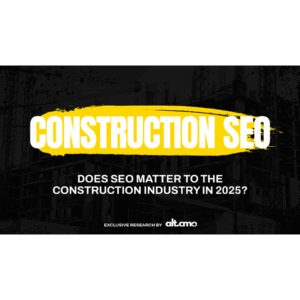
Most construction company websites are digital graveyards.
Static project galleries from 2015. Generic service descriptions that can be applied to any contractor. The same tired “about us” story that puts prospective clients and potential employees to sleep.
I’ve researched this extensively. Construction companies update their content approximately every 180 days. That’s six months of radio silence while competitors post weekly project updates, company news, and thought leadership.
Here’s what’s happening behind the scenes. When potential clients search for contractors, AI algorithms are making recommendations. They’re not just looking at your past work. They’re specifically noting which companies have “active relevant projects under construction.”
The credibility gap is massive. One contractor showcases a hospital project from 2015. Their competitor posts weekly updates from a hospital they’re building right now.
Which one would you choose if you’re a potential client or employee?
The Digital Brochure Problem
Most construction leaders treat their website like a printed brochure. Show the best past work. List capabilities. Wait for the phone to ring.
This approach worked when competition was local and referrals drove the majority of new business. Websites used to be a credibility check. Now, unique content is the most valuable marketing tactic according to 69% of construction marketers.
Yet most construction companies are falling behind in the digital content race.
Fresh Content Creates Competitive Advantage
Instead of waiting for project closeout to add work to your online portfolio, announce new projects in your company news feed. Create an “active projects” category and post progress based on specific milestones.
Your project managers are already sending regular progress reports to clients. Have them share those same updates with your marketing team.
The workflow eliminates the biggest pushback from PMs. They’re not creating extra work. They’re sharing existing client communications.
Safety concerns are valid. Loop your safety department in to double-check photos before sharing on your website, social media, or marketing materials. (But PMs shouldn’t be sending clients progress photos with safety issues anyway.)
But here’s the competitive advantage. When AI systems recommend 4-6 construction companies with specific market sector expertise in a region, they may specifically state that your company has active relevant projects under construction.
Primary Research That Competitors Cannot Replicate
AI algorithms also prioritize original research because it’s impossible for competitors to duplicate your exact dataset.
Construction companies sit on treasure troves of original content opportunities.
Survey 20+ clients with the same 5-8 questions about industry trends. Combine responses, look for commonality, share interesting outliers. Transform those insights into reports, blog posts, infographics, social posts, webinars, or podcast episodes.
The questions that reveal unexpected insights:
“What’s your biggest fear for your industry in 10+ years?”
“What design trends should die?”
“What’s your biggest headache in the construction process?”
These questions force clients to think beyond their immediate project needs. They reveal industry patterns that can only be documented by someone actively working in the field.
 You can also conduct research without interviews, like we did with my Construction SEO Report.
You can also conduct research without interviews, like we did with my Construction SEO Report.
Here are some ideas for contractors:
- Evaluate 10+ building projects in similar geography or market sectors.
- Document the cost per square footage across different market sectors.
- Share future predictions based on your field observations.
Content Strategy That Matches Your Audience
Engineers want data. Architects want infographics. Contractors want memes like Construction Yeti.

Your content should match how different audiences consume information. Mix up your formats and test what your market actually engages with.
Repurpose your primary research across different mediums. Turn client survey results into detailed reports for engineers, visual infographics for architects, and social posts for contractors.
The same research should be shared across multiple content pieces that cater to different audience preferences, including webinars, blog posts, social posts, podcast episodes, guest appearances on other podcasts, and even sharing with industry media.
Measuring Real Business Impact
Track web traffic by channel, social engagement, and inbound inquiries. But also pay attention to conversations.
Research elevates you as a thought leader in the industry. When potential clients recognize you as a subject matter expert, the sales process undergoes a fundamental shift.
Thought leadership reduces competitors and eliminates the low-bid mentality. People pay more for expertise and talk with fewer contractors during their selection process.
You’re no longer competing primarily on price. You’re competing on knowledge, current experience, and industry insights that competitors cannot match.
The Evolution Beyond Low Bid
Construction is moving beyond the lowest bid wins mentality. The companies that will dominate the next decade are investing in deeper research, developing genuine subject matter expertise, and sharing insights that position them as industry leaders.
The next evolution requires audience-specific content strategies.
Start simple. Add your current projects to your website and start writing about your clients’ most significant challenges and pain points.
Construction companies that understand the relationship between fresh content, primary research, and competitive positioning will capture a disproportionate market share, while their competitors remain invisible to AI algorithms and potential clients alike.

